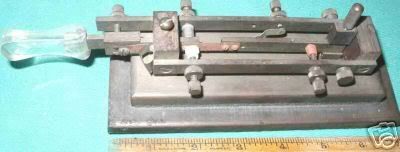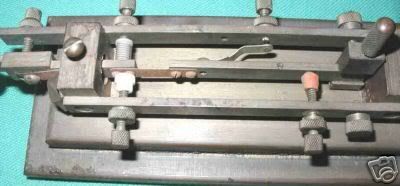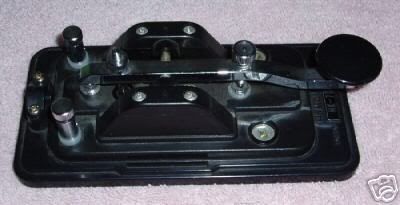And he had a bundle of boxes this morning, too.
I was waiting for one of the most unusual semi-automatic bugs I've ever seen to arrive, and it was in today's mail.

This key has no ID tag or name or any identifying marks. It could be a homebrew key, but it looks as though it was made for a specific purpose — plus, it uses a system that avoids infringing on the Vibroplex bug patent. The workmanship is excellent, and if this is a homebrew key, it was done by someone who knew what he or she was doing.
Pictured at right is the bug. The seller wasn't real savvy about keys, and had no real information on it. It is unusual but fairly straightforward.
The outer bars are brass, and each has a terminal screw near the rear for attaching a cable. The keying lever sits between the bars. Separating the bars on both ends are phenolic blocks, The bars don't touch the base, only the phenolic blocks on each end.
The keying lever is interesting because it dodges infringing on the Vibroplex patent for its vibrating arm. With a Vibroplex, the arm is set in motion when the lever handle is pushed to the right by the operator; the arm swings until it hits the stop, and the sudden stop is what sets the arm into vibration.
This key avoids infringement because instead of putting tension on the arm to cause the vibration, this key releases the arm under tension. It may sound like a minor point, but for many telegraph key makers, it was the only system they could devise to avoid Vibroplex's attorneys.

Moving the keying lever handle to the right moves the arm away from its stop, and this starts the vibrating motion. There is a stop to adjust for the lever as it moves left, but this is only to allow adjustment for the dit length and weight. It has nothing to do with really making the arm vibrate.
I spent about 20 minutes playing with the key's adjustments. The contacts were serviceable, but still need cleaning.
How does it work? It's a very different animal compared to the typical vibrating-arm type bug. The keying arm does not have the same type of vibration as the Vibroplex. The vibrations are much weaker, and the dits are extremely short duration. If you try to adjust the key for stronger dits, it tends to further dampen the keying lever vibration. In short, you wind up with a keying arm that only gives you 2 or 3 dits before coming to a stop.
I've read that other keys of this type (that use the “release” method for generating dits) had similar problems. I've never liked the bug operators who have the extremely short dits. This key's dits are as short as some I've heard, but they sound a bit out of balance at the speed I run.

In other boxes that came today I picked up a couple of old Vibroplex bug bases, one Original and one Lightning Bug, and a Hi-Mound HK-708 straight key. Yeah, I know, I don't use straight keys much, but I have always wanted to try one of the Hi-Mound straight key
This is a fairly inexpensive key new, so I wasn't interested in paying much — and I didn't. You don't see Hi-Mound keys on eBay often, other than the very common “coffin” bug. The straight keys don't pop up often. I expected it to be a key with a very cheap feel, though all of the Hi-Mound keys I've tried have been of good quality and excellent to operate.
I was surprised at the precision feel the key has. It sits still on the desk, and has a very balanced feel. I think the feel of the Hi-Mount beats my Speed-X straight keys, at least for comfort. I'll keep this one handy for SKN, provided I don't re-sell it first.
Field Day preparation awaits … 73 es cul … de KY4Z … dit dit
